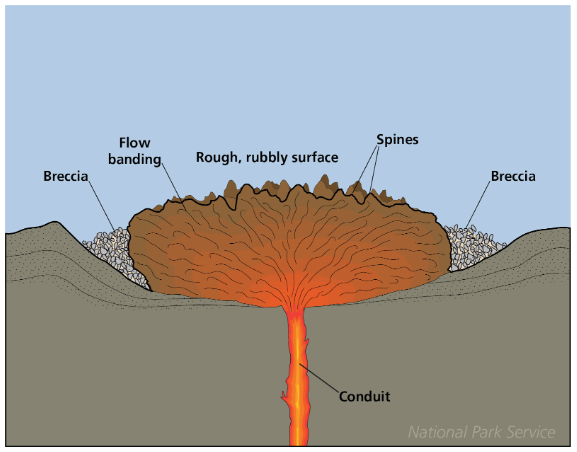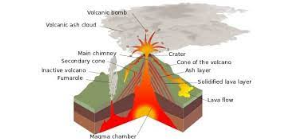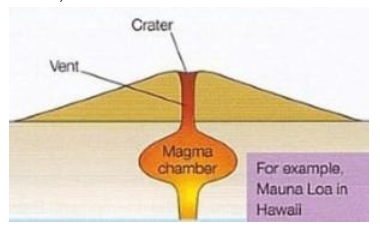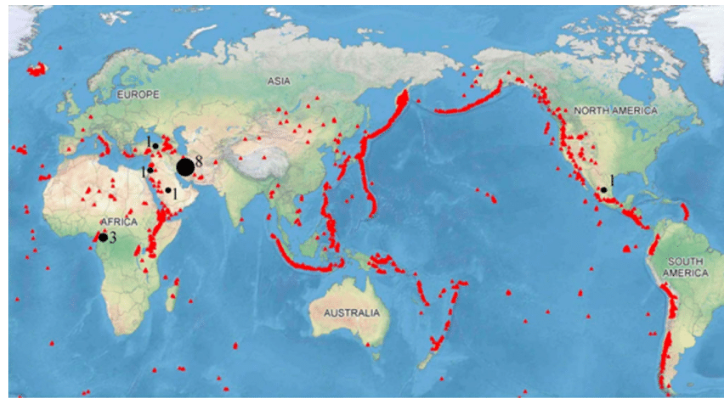Volcanoes - Causes, Types, Distributions
VOLCANOES
- Volcanoes are the geological structures that form when magma from within the Earth's upper mantle works its way to the surface.
- The molten rock, called lava when it reaches the Earth's surface, along with ash, gases, and rock fragments, can erupt through the vent of the volcano.
- This entire process is known as volcanism.
- The type of eruption, whether explosive or effusive, is largely dependent on the composition of the magma, the amount of gas contained within it, and the structure of the volcano.
CAUSES OF VOLCANISM
- PLATE TECTONICS- The temperature differences and convection currents in the Earth's mantle are indeed responsible for the movement of tectonic plates.
- At divergent boundaries, where plates move apart, magma from the mantle can rise to the surface, creating volcanic activity. This often results in fissure-type volcanoes or mid-ocean ridges.
- At convergent boundaries, where plates move toward each other, one plate can be forced beneath the other in a process called subduction.
- This subduction can create intense pressure and heat, causing the subducted plate to partially melt and form magma. This magma can eventually make its way to the surface, leading to explosive volcanic eruptions, often associated with volcanic arcs.
- The relationship between plate tectonics and volcanic activity is a fundamental concept in earth sciences and helps us understand the distribution of volcanoes and earthquakes around the world.
TYPES OF VOLCANO
BASED ON SHAPE
CINDER CONES Cinder cones are typically circular or oval-shaped formations composed of small lava fragments ejected from a sole vent.
- These cones develop as scoria and pyroclastic materials accumulate around the vent. Most cinder cones result from a single eruption event.
- They can be either satellite vents on larger volcanoes or exist independently as separate, isolated structures.

COMPOSITE VOLCANO Composite volcanoes, also known as stratovolcanoes, are characterised by their steep slopes and multiple layers consisting of various volcanic materials such as high-viscosity lava, ash, and rock fragments.
- These volcanoes form tall, conical mountains composed of layers of lava flows and other volcanic ejecta, which gives them their name "strata."
- The formation process involves the accumulation of cinders, ash, and lava in successive layers. Cinders and ash pile up atop each other, while lava flows over this material, cools, and solidifies. This cycle of layering contributes to the distinct structure of composite volcanoes.

SHIELD VOLCANO Shield volcanoes are characterised by their gently sloping sides formed by the flow of basaltic lava.
- They typically have a bowl-shaped or shield-like appearance in the centre.
- These volcanoes result from eruptions of low-viscosity lava that can travel considerable distances from the vent. Unlike other types of volcanoes, shield volcanoes do not usually erupt explosively.
- They are commonly found in marine environments as opposed to continental settings due to the low silica content in the low-viscosity magma. Shield volcanoes are prevalent in locations such as the Hawaiian volcanic system and are frequently observed in regions like Iceland.

LAVA DOMES form when highly viscous lava accumulates near the volcanic vent, creating a steep-sided mound due to the lava's inability to flow easily.
- These structures are the result of slow eruptions that involve highly viscous lava. They can occasionally appear within the crater of a previous volcanic eruption.
- Despite their slow, gradual eruptions, lava domes can occasionally erupt violently and explosively, similar to a composite volcano. However, the lava from these eruptions rarely travels far from the vent due to its high viscosity.

VOLCANISM LAVA TYPE
ANDESITIC OR ACIDIC LAVA
- Andesitic lava, found mostly along destructive boundaries (convergent boundaries), is highly viscous, with a high melting point. It has light colouring, low density, and contains a high proportion of silica.
- Due to its slow flow and quick solidification, the resulting volcanic cone is steep and exhibits stratification, earning it the name "stratovolcano."
- The lava's tendency to solidify rapidly in the vent often obstructs the outflow, leading to explosive eruptions.
- These explosions expel various volcanic bombs or pyroclasts.
- In certain cases, the highly viscous lava forms a solid plug at the crater, as seen in Mt. Pelée in Martinique, an island in the Lesser Antilles, Caribbean Islands.

BASIC OR BASALTIC LAVA
- Basaltic lavas, which are extremely hot at around 1,000°C, are highly fluid.
- These lavas are typically dark-coloured due to their richness in iron and magnesium but low silica content.
- When they flow out of a volcanic vent, it tends to happen quietly, resulting in less explosive eruptions. The high fluidity allows these lavas to travel at a speed of 10 to 30 miles per hour.
- Their remarkable fluidity allows them to cover extensive areas, spreading out as thin sheets over considerable distances before solidifying.
- The volcanoes formed by these types of lava flows have gentle slopes and wide diameters, shaping a flattened shield or dome.
- Basaltic lava flows are frequently observed along constructive boundaries (divergent boundaries).

DISTRIBUTION OF VOLCANOES
- The majority of volcanic activity and earthquakes are concentrated along converging plate margins and mid-oceanic ridges.
- Approximately 70 percent of earthquakes take place within the Circum-Pacific belt.
- Around 20 percent of earthquakes occur in the Mediterranean-Himalayan belt, which includes areas such as Asia Minor, the Himalayas, and portions of north-west China.
- Reports indicate that approximately 480 active volcanoes have been recorded since the 16th century.
Among these, nearly 400 are situated in and around the Pacific Ocean, while 80 are located in the mid-world belt that extends across the Mediterranean Sea, the Alpine-Himalayan belt, and within the Atlantic and Indian Oceans.
- Some of the areas with the highest concentration of volcanic activity include the Aleutian-Kuril islands arc, Melanesia, and the New Zealand-Tonga belt.
- It's important to note that only 10 to 20 percent of all volcanic activity occurs above the sea level, and terrestrial volcanic mountains are comparatively smaller in size when compared to their submarine counterparts.

FAQs related to volcanoes and various types of volcanic formations:
1. What is a volcano?
Ans. A volcano is an opening or vent in the Earth's crust that allows magma, ash, and gases to escape from below the surface. It can either be active, dormant, or extinct based on its history of eruptions.
2. What are the different types of volcanoes?
Ans. There are several types of volcanoes, such as:
- Shield Volcanoes: Have gentle slopes formed by lava flows.
- Stratovolcanoes (Composite Volcanoes): Tall and steep with layers of lava, ash, and rock debris.
- Cinder Cone Volcanoes: Small and steep-sided with fragments of scoria and pyroclastics.
- Lava Domes: Formed by viscous lava accumulating near the vent.
- Calderas: Large depressions formed by the collapse of the ground after an eruption.
3. What type of lava creates shield volcanoes?
Ans. Shield volcanoes are formed by low-viscosity basaltic lava that spreads in thin layers, leading to the gradual slope characteristic of these volcanoes.
4. What makes stratovolcanoes different from shield volcanoes?
Ans. Stratovolcanoes, also known as composite volcanoes, are steep-sided and composed of alternating layers of ash, lava, and debris. Shield volcanoes, in contrast, have gentle slopes primarily formed by fluid lava flows.
5. How do cinder cone volcanoes form?
Cinder cone volcanoes are formed by the accumulation of small fragments of scoria and pyroclastics around a single vent. They usually erupt once and are often smaller in size.
6. What causes the formation of a caldera?
Ans. Calderas are formed when the ground collapses after a volcanic eruption, creating a large, bowl-shaped depression. This occurs due to the emptying of the underlying magma chamber.
7. Where are the most common locations for volcanic activity?
Ans. Volcanic activity is concentrated along converging plate margins and mid-oceanic ridges. Approximately 70% of earthquakes occur in the Circum-Pacific belt, and another 20% take place in the Mediterranean-Himalayan belt.
8. What are the differences between submarine and terrestrial volcanoes?
Ans. Submarine volcanoes are located underwater and make up a significant portion of Earth's volcanic activity, although they tend to be larger compared to terrestrial (land-based) volcanic mountains, which are smaller in size and mostly found above sea level.

